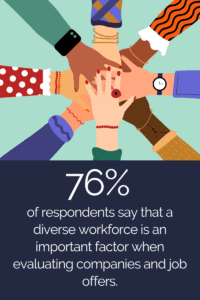Top roles have proven cumbersome for companies to fill. But with these proven strategies, leaders can quickly fill vacancies while hitting equity goals.
By Zee Johnson
A tight talent market is certainly not a time for HR and TA leaders to rest on their laurels. Instead, it’s the perfect opportunity to gain support for change and innovation. And one primary area of change for many organizations involves new strategies around diversity and inclusion. Clearly, today’s top candidates are seeking an inclusive workplace. In fact, research from Glassdoor finds that 76% of respondents say that a diverse workforce is an important factor when evaluating companies and job offers. Nearly a third would not apply to a job at a company where diversity is lacking.
“In order to compete, it’s important to innovate and stay ahead of the curve,” says Ross Dzurko, vice president, talent services for Sevenstep. “One of the best ways to do that is through diversity of thought, and often that means diversity of talent.”
 Though the task of overhauling existing systems can be daunting, expanding the hiring process to encompass a diverse pool of candidates can help organizations fill the roles that have long gone vacant. And for organizations to attract diverse talent, they must first ensure they are in fact promoting diversity.
Though the task of overhauling existing systems can be daunting, expanding the hiring process to encompass a diverse pool of candidates can help organizations fill the roles that have long gone vacant. And for organizations to attract diverse talent, they must first ensure they are in fact promoting diversity.
“Diversity attracts diversity,” says Sevenstep’s vice president, transformation, Natalie Scheiman. “There’s a lot you can do tactically to find and engage a diverse pool of candidates, but it really is important that you have invested in creating an inclusive and equitable culture. You have to invest first to be able to effectively attract a diverse pool of candidates.”
Building a Culture of Inclusion
Creating a culture of inclusion can happen in a number of ways, one being leveraging data. The right data provides leaders with a starting point to understand the current state of their culture and where improvements need to be made.
“Data is critical to define what you’re looking for,” Dzurko says. “By using the data to be more targeted, organizations will have a clear direction of where to focus.”
He explains that data points can help HR leaders answer questions like:
- Where does this talent live and breathe?
- Are they active online?
- Should we earmark a portion of the budget for grassroots sourcing efforts?
Addressing Concerns
Scheiman also says that data can identify problems within companies that may have otherwise been overlooked.
“Data is going to allow you to identify issues. It will ultimately help you to see where you have opportunities throughout the recruitment process,” she says. “Do you need to increase diversity at the top of the funnel to see if you even have a chance at achieving goals? Are you seeing key fallout points where candidates of certain diversity dimensions remove themselves from consideration because they don’t feel aligned with your brand or what you’re selling?”
Creating Diverse Talent Pools
In addition to data, companies must also be mindful of their language in job postings for positions at all levels. Specifically, tailoring language so that it isn’t consciously or unconsciously biased, like the usage of traditionally male-orientated words (i.e., active, adventurous, dominant, superior), can help secure the right people.
“Be sure to describe your organization and its opportunities with non-gendered language. Strong language might detract a certain population of candidates,” Scheiman says. “There’s a lot of research and tools that can help remove the type of language that makes people feel a certain way about a job, rather than look at a job objectively.”
By updating antiquated processes and creating diverse talent pipelines, organizations can fill vacancies while building an equitable culture and company where candidates want to work.
“If someone can see ‘there’s someone like me at this company,’ they’re much more likely to consider a career with that organization. That then opens up the talent pool to a whole new population of candidates,” Dzurko says.
Even as markets change, a slower hiring pace will not change the rules for hard-to-find talent. And an emphasis on diversity will remain critical to success. Check out Sevenstep’s recent Market Roundup for this and other issues that are influencing today’s workforce landscape.














